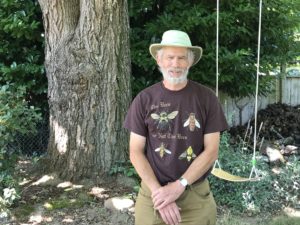Testimony welcome for tree code changes
By Sharon Kelly | CNA Media Team

Portland City Council will consider amendments to the five-year-old tree code, Title 11 Trees, in September and October to save more trees in Concordia and throughout Portland.
Bruce Nelson hopes neighbors will help influence the city council to approve the amendments. He’s a Cully resident, retired horticulture professor, Portland Urban Forestry Commission member and a founding member of Trees for Life Oregon (TFLO).
“We’re losing too many trees because it’s too easy to take them down,” he pointed out. “We’ll gradually lose older large trees, a lot of those to development.
“It happens one lot at a time,” he added. “But give it 40 years, and many will have to go to a park to sit under the shade of a tree. It’s not that people are opposed to trees, they just don’t make trees a priority.”
Jim Gerbach, Concordia resident, neighborhood tree steward and also a founding member of TFLO explained, “Concordia has a lot of smaller affordable homes and has already been targeted for in-fill development and the construction of duplexes.”
According to Jim, with the August approval of the Residential Infill Project, infill will accelerate with four to six homes on a lot.
“It’s important that Concordians know about the protections for trees in their neighborhood and speak up, or they may find that trees they’re used to seeing will not be there.”
What’s proposed
In an effort to strengthen the existing tree code and address inequities, city staff proposes the requirement that trees on private property with a diameter of 20 inches or larger be preserved, or developers pay mitigation fees for removal. Currently, the preservation threshold measurement is 36 inches.
City council will also vote on removing exemptions from some properties zoned commercial and industrial.
Concordia Neighborhood Association (CNA), TFLO, Audubon Society and many other tree advocates call for support, even stronger code and incentives for creative design to protect trees.
“We encourage the city to remove minimum lot size exemptions … ensuring our neighborhood’s tree profile remains consistent throughout,” reported a letter to the city from CNA signed by chair Astrid Furstner.
Prior to the implementation of Title 11 in 2015, there were few protections for Portland’s trees, and regulations were scattered among a variety of city codes. The only tree regulations regarding development were related to land division, so there was an incentive for developers to remove trees before applying for a land division permit.
The current tree code is helping preserve some trees, and these new amendments will increase the incentives to keep trees standing, but with the continuing development boom in Portland, there are many competing priorities for the increasingly valuable space of urban lots.
“The public testifying, showing interest and bringing attention to the tree code makes a big difference,” Bruce reported. “The Urban Forestry department really needs citizen support. Otherwise they are just a teeny, tiny player and can get overwhelmed by larger bureaus and planning goals.”
“Cully and Concordia are poised to benefit from these amendments.” Bruce said. “Lowering the tree protection to 20 inches will save many more trees and save a diversity of trees, or generate funding for tree planting and preservations, while the 36 inches really only protected a few large Doug Firs.”
He also noted, “We are bordered by industrial lands along Columbia Boulevard, and are subject to the air pollution and heating caused by these low-canopy, high-industry areas.”
The city acknowledges on its frequently-asked-questions web page that more – not fewer – trees are needed. It reads: “Tree canopy tends to be low, and the prevalence and intensity of urban heat islands are higher near areas where higher percentages of people of color and those with limited English language proficiency live.”
Recognizing the historical relationship between low-canopy areas, low-income communities and communities of color brings another concern that tree preservation exemptions for affordable housing projects may serve to perpetuate this inequity.
“In the quest to meet the goal of affordable housing, we’re sacrificing the livability for those residents,” Jim said.
“We believe all people, whether they live in an apartment, duplex or quadruplex, deserve the benefits of large, spreading canopy trees, to provide a source for contact with nature, reduced noise and stress.
“We don’t believe that it’s an either-or choice,” he added. “We believe in finding creative solutions and innovative ways to have affordable housing and the tree canopy that makes it livable.”
Another pertinent tree issue for Concordia and Cully, where many homes have unimproved frontages, is the threat to trees in meeting the Portland Bureau of Transportation design standards and installing curbs and sidewalks during new development.
Local developer Eli Spevak told TFLO that, in local neighborhoods, many large trees sit in or close to the sidewalk. Submitting an appeal to adjust the Cully Grove sidewalk cost him a month and a few hundred dollars for the application fee.
But the real cost went for his engineer, because a curved sidewalk is more expensive to design and build than a straight one.
“Talented landscape designers and architects will find ways to work around existing trees … we look forward to seeing the results,” the CNA letter assured.
To maintain large trees and the space for them to grow, along with meeting needs for affordable housing, improved walkability and opportunities for jobs and industry, creative solutions and designs are what these tree advocates are calling for – and the code to back it up.
What can you do?
If you want to learn more about the need for tree equity, visit:
If you want to weigh in on proposed code amendments, here are the key dates:
- Sep. 8: Planning and Sustainability Commission and Urban Forestry Commission joint public hearing
- Sept. 17: Urban Forestry Commission meeting and vote
- Sept 22: Planning and Sustainability Commission meeting and vote
- Oct. 29: Portland City Council public hearing – written testimony also accepted prior to the in-person hearing
For details about those dates and testifying, visit TFLO.
Talking points about the code amendments are available at Portland Audubon.
For more information from the city and to submit comments, email
Emily.Sandy@PortlandOregon.gov.
 Sharon Kelly uses her outreach and coordination skills to support trees, farmers, small businesses, and engage people to create more healthy, equitable, sustainable communities. She’s best known locally as market manager for Cully and Woodlawn farmers markets and as web manager for Trees for Life Oregon. Contact her at NaturalFarmerPDX@gmail.com.
Sharon Kelly uses her outreach and coordination skills to support trees, farmers, small businesses, and engage people to create more healthy, equitable, sustainable communities. She’s best known locally as market manager for Cully and Woodlawn farmers markets and as web manager for Trees for Life Oregon. Contact her at NaturalFarmerPDX@gmail.com.
Tree code details
In case you’re wondering exactly what the city’s current tree code is all about, here are some highlights from the implementation of Title 11:
- Required preservation during new development of one-third of healthy trees greater than 12 inches diameter on the site/lot, or pay mitigation fee
- Required preservation of all healthy trees greater than 36 inches diameter, or pay increased per-inch mitigation fee for the removal of these larger trees
- Tree removal permits required for trees greater than 12 inches in diameter on private property
- Centralized tree policies and tree information
- Tree Fund created to direct mitigation fees toward urban canopy projects
Some notable exemptions, where the tree code does not apply, or owners/developers are not required to pay mitigation fees for tree removal, include (there are several others):
- Sites less than 5,000 square feet
- Sites zoned as commercial or industrial
- Sites being developed for affordable housing